I.The West (part 2)
The Theatre of the Absurd is totally lyrical theatre which uses abstract scenic effects, many of which have been taken over and modified from the popular theatre arts: mime, ballet, acrobatics, conjuring, music-hall clowning. Much of its inspiration comes from silent film and comedy, as well as the tradition of verbal nonsense in early sound film (Laurel and Hardy, W C Fields, the Marx Brothers).
It emphasises the importance of objects and visual experience: the role of language is relatively secondary. It owes a debt to European pre-war surrealism: its literary influences include the work of Franz Kafka. The Theatre of the Absurd is aiming to create a ritual-like, mythological, archetypal, allegorical vision, closely related to the world of dreams.
Some of the predecessors of absurd drama:
- In the realm of verbal nonsense: François Rabelais, Lewis Carroll and Edward Lear. Many serious poets occasionally wrote nonsense poetry (Johnson, Charles Lamb, Keats, Hugo, Byron, Thomas Hood). One of the greatest masters of nonsense poetry was the German poet Christian Morgernstern (1871-1914). Ionesco found the work of S J Perelman (i.e. the dialogues of the Marx Brothers’ films) a great inspiration for his work.
- The world of allegory, myth and dream: The tradition of the world as a stage and life as a dream goes back to Elizabethan times. Baroque allegorical drama shows the world in terms of mythological archetypes: John Webster, Cyril Tourneur, Calderon, Jakob Biederman. With the decline of allegory, the element of fantasy prevails (Swift, Hugh Walpole).
- In some 18th and 19th Century works of literature we find sudden transformation of characters and nightmarish shifts of time and place (E T A Hoffman, Nerval, Aurevilly). Dreams are featured in many theatrical pieces, but it had to wait for Strindberg to produce the masterly transcriptions of dreams and obsessions that have become a direct source of the Absurd Theatre. Strindberg, Dostoyevsky, Joyce and Kafka created archetypes: by delving into their own subconscious, they discovered the universal, collective significance of their own private obsessions. In the view of Mircea Eliade, myth has never completely disappeared on the level of individual experience. The Absurd Theatre sought to express the individual’s longing for a single myth of general validity. The above-mentioned authors anticipated this.
Alfred Jarry is an important predecessor of the Absurd Theatre. His UBU ROI (1896) is a mythical figure, set amidst a world of grotesque archetypal images. Ubu Roi is a caricature, a terrifying image of the animal nature of man and his cruelty. (Ubu Roi makes himself King of Poland and kills and tortures all and sundry. The work is a puppet play and its décor of childish naivety underlines the horror.) Jarry expressed man’s psychological states by objectifying them on the stage. Similarly, Franz Kafka’s short stories and novels are meticulously exact descriptions of archetypal nightmares and obsessions in a world of convention and routine.
- 20th Century European avant-garde: For the French avant-garde, myth and dream was of utmost importance: the surrealists based much of their artistic theory on the teachings of Freud and his emphasis on the role of the subconscious. The aim of the avant-garde was to do away with art as a mere imitation of appearances. Apollinaire demanded that art should be more real than reality and deal with essences rather than appearances. One of the more extreme manifestations of the avant-garde was the Dadaist movement, which took the desire to do away with obsolete artistic conventions to the extreme. Some Dadaist plays were written, but these were mostly nonsense poems in dialogue form, the aim of which was primarily to ‘shock the bourgeois audience’. After the First World War, German Expressionism attempted to project inner realities and to objectify thought and feeling. Some of Brecht’s plays are close to Absurd Drama, both in their clowning and their music-hall humour and the preoccupation with the problem of identity of the self and its fluidity. French surrealism acknowledged the subconscious mind as a great, positive healing force. However, its contribution to the sphere of drama was meagre: indeed it can be said that the Absurd Theatre of the 1950s and 1960s was a Belated practical realisation of the principles formulated by the Surrealists as early as the 1930s. In this connection, of particular importance were the theoretical writings of Antonin Artaud. Artaud fully rejected realism in the theatre, cherishing a vision of a stage of magical beauty and mythical power. He called for a return to myth and magic and to the exposure of the deepest conflicts within the human mind. He demanded a theatre that would produce collective archetypes, thus creating a new mythology. In his view, theatre should pursue the aspects of the internal world. Man should be considered metaphorically in a wordless language of shapes, light, movement and gesture. Theatre should aim at expressing what language is incapable of putting into words. Artaud forms a bridge between the inter-war avant-garde and the post-Second-World-War Theatre of the Absurd.
(to be continued…)


















